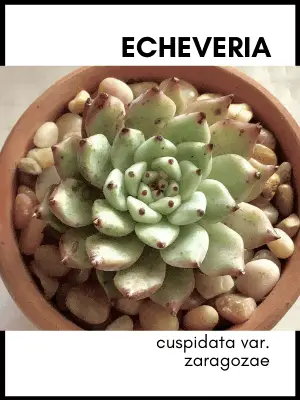
Growing Season:
Summer
Dormant Season:
Winter
Hardy to USDA Zone: 10a- Size: Up to 4″ wide
- Foliage: Glaucous Light Green with Red/Purple Tips
- Flower: Pink/Orange
Propagation: Stem cuttings, leaves, seed, offsets
Light: Full sun, bright shade
Water: Drench & Dry
Soil: Gritty, mostly inorganic, quickly draining- Origin: Nuevo Leon (Near Zaragoza), Mexico
Echeveria: The Beautiful Succulent for Every Garden
Echeveria is a stunning succulent that has been gaining popularity in recent years for its unique and beautiful foliage. These plants are native to Mexico and Central America and are known for their rosette shape and colorful leaves. They are a great addition to any garden or landscape and can even be grown indoors. In this blog post, we will explore the different types of Echeveria, their care and maintenance, and how to incorporate them into your garden design.
Care and Maintenance
Echeveria is a relatively low maintenance plant, making it a great option for both experienced and novice gardeners. Here are a few things to keep in mind when caring for your Echeveria:
Light and Temperature
Echeveria prefers bright, indirect sunlight. They can tolerate some shade, but too much will cause the colors to fade. These plants prefer temperatures between 60-80°F (15-26°C) and should be protected from frost.
Watering and Soil
Echeveria should be watered deeply but infrequently, allowing the soil to dry out completely before watering again. These plants prefer well-draining soil and should be planted in a pot with drainage holes.
Propagation and Potting
Echeveria can be propagated easily from leaves or offsets. Simply remove a healthy leaf from the base of the plant and allow it to callus over for a few days before planting. Be sure to use a well-draining soil mix when potting Echeveria.
Common Problems and Solutions
One of the most common problems with Echeveria is over-watering, which can lead to root rot. Be sure to allow the soil to dry out completely before watering again. If you notice yellowing or wilting leaves, it is likely a sign of under-watering. Echeveria is also susceptible to mealybugs, which can be controlled with a solution of water and dish soap.
Design and Decorating with Echeveria
Echeveria is a versatile plant that can be used in a variety of ways in your garden. Here are a few ideas:
- Use Echeveria in rock gardens or as ground cover.
- Combine Echeveria with other succulents for a stunning display.
- Incorporate Echeveria into your patio or deck decor.
- Use Echeveria in mixed container gardens.
Climate Zones
Echeveria is hardy in zones 9-11, which means it can survive in areas where the temperatures are relatively warm all year round. In colder zones, they can be grown as indoor plants or in containers that can be brought inside during the winter.
Conclusion
Echeveria is a beautiful and unique succulent that can add a touch of color and elegance to any garden or landscape. With its low maintenance requirements and wide variety of shapes, sizes, and colors, there is a Echeveria for every taste. By following the care and maintenance tips outlined in this blog post, you can ensure your Echeveria thrives for years to come.
Additional Resources
- For more information on Echeveria and other succulent varieties, check out the website of the International Succulent Introductions (ISI) which is an organization that promotes the cultivation, preservation, and study of succulent plants.
- The Cactus and Succulent Society of America (CSSA) is another great resource for information on Echeveria and other succulents.
We hope this blog post has inspired you to add Echeveria to your garden or landscaping. Share your experiences and photos with us, we would love to see how you incorporate this beautiful plant into your own garden!
Echeveria zaragozae is also known as E. cuspidata var zaragozae. It has reddish purple tips on its pale green leaves for a dramatic color contrast.
Echeveria zaragozae stays pretty compact and blooms beautiful pink/orange flowers between March and May.
Be sure to never let your Echeveria zaragozae sit in water or moist soil for too long by planting it in well draining soil and providing it with lots of ventilation.
Give Echeveria zaragozae lots of morning sun and protect it from direct sunlight during the hottest part of the day.
